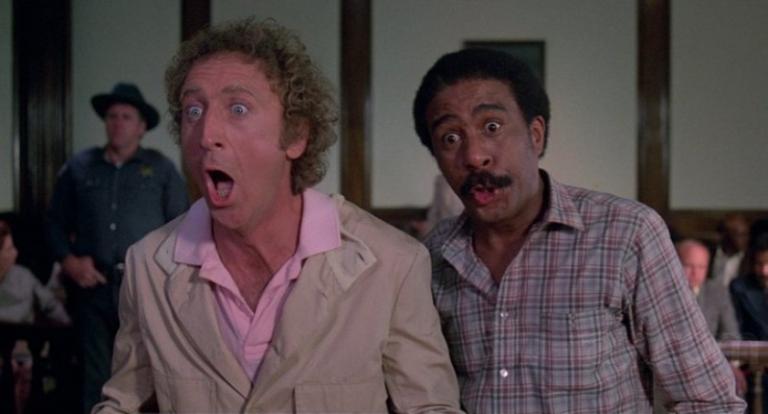The latest in a month-long series of re-posts from my Facebook marathon in April 2020.
–
Thirty years after his first big-screen role, and eight years after he directed a movie for the first time, Sidney Poitier finally made a film in which he himself did not appear — Stir Crazy (1980), starring Gene Wilder and Richard Pryor — and it turned out to be one of his biggest hits ever.
Indeed, it grossed $101.3 million in North America, a phenomenal amount at a time when only two or three movies a year crossed the century mark. It was the third-highest-grossing film of 1980, after The Empire Strikes Back and 9 to 5.
Stir Crazy was also the top-grossing film by a black director until Keenen Ivory Wayans’ Scary Movie came out twenty years later — and if you adjust for inflation, it was arguably the top-grossing film by a black director in North America until 2018’s Black Panther (though other films, such as 2017’s The Fate of the Furious, had presumably already beaten Stir Crazy internationally, even after adjusting for inflation).
My post on this film is going to be a little different from the other posts in my Sidney Poitier marathon. The rest of this marathon is based on a binge-watch that I did in April of last year. But before I did that binge-watch, I did a triple-bill of Wilder-Pryor collaborations, including this one. So the bulk of this post will consist of what I wrote at the time about that triple-bill, before I had seen most of Poitier’s earlier films.
–
Yesterday’s 1980s (and 1970s) catch-up: Silver Streak (1976), Stir Crazy (1980) and See No Evil, Hear No Evil (1989), the latter two of which are currently streaming on Netflix.
I’m not all that familiar with Gene Wilder and Richard Pryor, so I don’t know what sort of relationship they had outside of the films that they made together, but when I saw that the two films they made in the 1980s were streaming on Netflix (one of which was directed by Sidney Poitier, which was interesting in and of itself), I figured I’d check them out, along with the 1970s film that first put them together onscreen. (Note: onscreen. The first film that they both worked on was 1974’s Blazing Saddles, which starred Wilder and was co-written by Pryor.)
And… well, the law of diminishing returns certainly applies here. Blazing Saddles is an all-time classic, Silver Streak is a solid if unexceptional blockbuster, Stir Crazy is mildly interesting, and See No Evil is dull, contrived and gimmicky. (Wilder and Pryor went on to co-star in one more movie together — 1991’s Another You — but I don’t think I had even heard of that film until I scanned the IMDb for Wilder-Pryor collaborations, and I couldn’t find it on any streaming or VOD services.)
Anyway. Silver Streak is actually a decent bit of popcorn entertainment, and I am not at all surprised to learn that it was one of the top five box-office hits in 1976 (behind Rocky, the A Star Is Born remake and, um, the King Kong remake). It’s a sort of Hitchcockian thriller-comedy — Gene Wilder witnesses a murder on a train, nobody believes him at first, and then he becomes the chief suspect — and it’s got a bit of romance and a bit of climactic disaster-movie footage at the end to go with the other genre elements. Plus it has some notable supporting actors, including Ned Beatty as a fellow passenger, Scatman Crothers as a porter, and Patrick McGoohan as the main villain. (I happened to watch 1979’s Escape from Alcatraz a couple nights earlier, and McGoohan was in that, too!) So it feels very much like a movie that the studio had some sort of confidence in.
I was a bit surprised, given that Pryor is one of the three top-billed actors (along with Wilder and Jill Clayburgh), to see that Pryor doesn’t actually appear until over an hour into the film — and one of the first things he does is encourage Wilder to pretend to be black in order to sneak back aboard the train. (Pryor even cites the Al Jolson precedent when telling Wilder to put shoe polish all over his face.) I’m curious as to how audiences, including black audiences, responded to this at the time, and how the response might have paralleled or differed from the response such a bit might get nowadays.
Weirdly, Silver Streak plugs into the James Bond films of that era. It features a sheriff played by Clifton James, who had previously played Sheriff Pepper in 1973’s Live and Let Die and 1974’s The Man with the Golden Gun (and who would go on to play another sheriff in 1980’s Superman II), and it also features Richard Kiel as a killer with metal teeth, before Kiel played Jaws in 1977’s The Spy Who Loved Me (which also features fight scenes on a train!) and 1979’s Moonraker. One other face I was happy to spot was a very young Fred Willard, as a guy who has to help evacuate the train station at the very end of the film.
I also liked some of the time-capsule elements in Silver Streak, e.g. the multiple jokes about those damn hippies, and the shot that begins by lingering on a passenger’s bottle of Tab. Apparently Tab had been around since 1963 — and it’s still made today! — but it largely faded from the market after the Coca-Cola company introduced Diet Coke in 1982.
One niggly nit-pick: When McGoohan’s character is leaning out of the train and sees another train rushing towards his head, the point-of-view shots of the oncoming train are clearly taken by a stationary camera and not by a camera that is rushing towards the train like McGoohan’s character would have been.
As for the other two movies…
Not surprisingly, they recycle some bits from Silver Streak. Stir Crazy and See No Evil both feature Wilder being accused of crimes he didn’t commit, and this time Pryor is blamed for the crimes too. In Stir Crazy, after Wilder and Pryor are thrown in jail, Wilder tries to act “tough” around the other prisoners in a way that recalls his dorky attempts to pass himself off as a black man in Silver Streak, and See No Evil recycles the plot device where Wilder sees a front-page newspaper story accusing him (and Pryor) of the crime. (See No Evil was directed by Arthur Hiller, who also directed Silver Streak.)
Stir Crazy was directed by Poitier, the first black man to win an Oscar for acting (in 1963’s Lilies of the Field), and it is interesting to watch nowadays in light of the recent push towards “diversity” in film. Wilder and Pryor both plan to escape their imprisonment — in a manner that, for me, recalls the World War II POW film Victory, which came out one year later (both films involve escape attempts that take place when prisoners are taken out of the prison to participate in sporting events) — and Wilder and Pryor are joined in their plan by an Hispanic prisoner and a gay black prisoner.
The gay prisoner’s story arc is particularly interesting: he flirts with Pryor at first, and Pryor finds it super awkward, but by the end, when the escapees are putting on their disguises, Pryor has no trouble letting the gay prisoner dress as a woman and pretend to be his partner as part of the escape plan. It is only after they have all escaped that things get awkward again for Pryor, as the gay prisoner gives him a quick farewell kiss on the lips. But the humour here is essentially at Pryor’s expense, even if one assumes that many in the audience would have identified with Pryor as he tries to wipe his lips clean. At no point is the gay prisoner “punished” or chastised or anything like that; the film is essentially happy to let that character be who he is. (I do wonder, though, if anyone back in the day objected to the fact that the white man “gets the girl” in the end, i.e. a lawyer played by JoBeth Williams, while the black man has to deal with another man’s attraction to him.)
See No Evil, meanwhile, has its own issues. The gimmick here is that Wilder plays a deaf man and Pryor plays a blind man, and between the two of them they “witness” a murder but have a hard time convincing anyone else of that; and both of these characters insist on “passing” as able-bodied people, which Pryor’s sister says is just as bad as a black person trying to “pass” as white. The film’s credits indicate that the movie was made with input from the disabled community, but I wonder if the movie’s release 31 years ago was greeted by the sort of op-eds that one routinely sees nowadays which insist that only disabled actors should be allowed to play disabled characters.
On a completely different culturally-touchy front, Pryor speaks in exaggerated foreign accents while pretending to be Swedish and “Middle Eastern”, as the closed captioning puts it. (The latter scene takes place during an anti-Khomeini, pro-democracy-in-Iran protest outside a police station; for context, the film came out one year after the Iran-Iraq War came to an end, and just a few months after the Ayatollah Khomeini issued a fatwa against Salman Rushdie for writing The Satanic Verses.)
See No Evil also goes out of its way to make a sexual spectacle of the female villain. In one scene, after she has stepped out of a shower, Wilder tricks her into dropping her towel by sticking his hand in his pocket, pretending his erection is a gun, and telling her to put her hands up. The scene makes absolutely no sense: Why would a hardened killer be fooled by this? Usually, when someone pretends to have a gun in his or her pocket, it’s because they’re out in public and everyone assumes the person wants the gun to stay hidden. But this is a movie in which the bad guys have already pointed their guns at people on an open sidewalk, and have openly said that they don’t have to wait until they’re in an alley before killing their captives. So why would the hand-in-the-pocket trick work in a private hotel room? Answer: Because Wilder needs the sexy lady to be naked, exposed and vulnerable so that he can kiss her without her consent.
Anyway. From Silver Streak to Stir Crazy and See No Evil, you can see the filmmakers’ ambitions getting smaller, with smaller setpieces and fewer recognizable supporting actors. But it’s fun to spot now-familiar actors at earlier stages of their careers. Craig T. Nelson makes one of his earliest big-screen appearances as a prison guard in Stir Crazy, and Kevin Spacey makes his fourth big-screen appearance ever as a villain with a moustache and a British accent in See No Evil.
–
Thus endeth my original Facebook post about the Wilder-Pryor triple-bill.
When I got to Stir Crazy in my Poitier marathon last year, I linked to my earlier post and added two extra notes, in addition to the box-office data that I mention above:
— This was the second Poitier-directed film to feature Richard Pryor, after the latter’s bit part in 1974’s Uptown Saturday Night.
— This is the only Poitier-directed film that was rated R, mainly it seems because it is also the first Poitier film in which anyone uses the f-word (and it is used several times).
–
The image above shows Gene Wilder and Richard Pryor in Stir Crazy.














